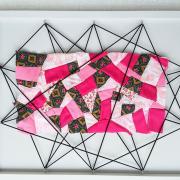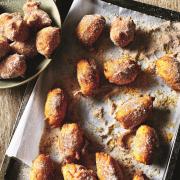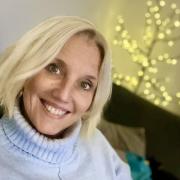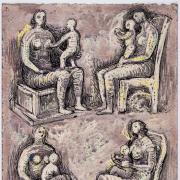Best-selling author Joanne Harris returns to the sights, sounds and smells of a French village for a fourth bite of Chocolat.
When Joanne Harris writes about the scent of Criollo beans in a grinder, ‘very far from sweet … seductive, yet faintly unsavoury, like a beautiful woman with unwashed hair,’ her eloquence and precise choice of words surround the reader with a ghostly essence of oud, ambergris, nutmeg and cardamom.
Her writing, particularly in the Chocolat series, skilfully engages all the senses, bringing not only the sights and sounds of everyday life in the small village of Lansquenet-sous-Tannes into vivid focus, but also turning a sharp eye – and inquisitive nose – on its distinct aromas.
And now, with The Strawberry Thief, the fourth instalment in the lives of chocolatier Vianne Rocher and her daughters, Anouk and Rosette, she has gone one step further, working with a leading fragrance manufacturer to create a ‘scent illustration’.
‘I have a very particular way in which I experience the world and I have tried to share it in my work,’ says Joanne. ‘I thought for a very long time that everyone experienced life as I did. I can smell colours and certain colours in bright light can trigger scents for me. I thought that’s what it was like for everyone.’
Her synaesthesia means she often notices scents before anything else, so her descriptions tend to start with smells and flavours rather than sights and sounds. She associates all of her novels with a particular scent – a fragrance to get her in the writing zone – but she has always kept those scents for herself. Until now.
Inspired by a passage in which a character grinds some Criollo beans, Xocolatl has been specifically designed for the spring launch of The Strawberry Thief, with bright notes of vanilla and popcorn added to a darker base of amber, chypre, cumin, bitter chocolate, cedar and sandalwood.
The author, who describes it as ‘strange and unusual – and not entirely comfortable’, is planning to use it to scent bookmarks and to diffuse the room at readings.
‘I wonder if it will actually change the way people perceive the story?’ she says, before returning to a subject she has been inextricably linked with for 20 years: chocolate.
‘It’s not easy to write about the flavour and scent of chocolate. It is not sweet. There’s a lot of bitterness in chocolate too. I think if people pick up Chocolat expecting a sweet book, they might be disappointed.
‘The books started dark and have become darker. I wanted to convey the complexity and emotional resonance of chocolate. People are very conflicted about it. It carries a lot of guilt.’
In The Strawberry Thief, which the author will be discussing at Huddersfield Literature Festival on March 30th, Vianne has finally settled down in the village that once so dramatically rejected her, running her chocolate shop in the square with the help of Rosette, her ‘special’ child. But their truffle-smooth days are soon thrown into disarray when Narcisse, the florist, dies, leaving a parcel of land to Rosette and a written confession to Reynaud, the priest.
When Narcisse’s relatives arrive and a strangely appealing new shop opens in place of the florist’s, an unmistakeable whiff of confrontation begins to waft across the square with base notes of turbulence and just the faintest hint of murder.
‘It’s not that I keep coming back to these characters; it’s that they keep coming back to me,’ says Joanne. ‘I was not aware when I started writing Chocolat that I was starting a series of books. I have a number of recurring characters throughout my novels, but I never know who will return or when they will appear.
‘I like to be surprised as I write. I have a vague idea of where I’m heading, but the twists and turns along the way are often as surprising to me as to the reader. I have a very short attention span, so there has to be an element of discovery otherwise why would I want to sit and write it. My books are based on twists, revelations and surprises. I have to surprise myself if I have any chance of surprising the reader.’
She claims to be ‘quite a lazy person’. If she is, then she hides her sloth well behind a mountain of projects as diverse as novels, libretti, screenplays, musicals, cookbooks and her Storytime Band, which shares stories and music as part of a live touring show.
‘There’s so much more to being a writer than just writing,’ Joanne explains. ‘There’s publicity and events and festivals. I have my journalism and travel writing, and I’m also working on two musicals at the moment. I have got to the point in my life when I feel happy to give myself permission to have the odd day off though; to enjoy my garden or to listen to music or just to read a book.
‘It’s important for all writers to ready widely. I get an awful lot of stuff sent to me, which can be useful as it pushes me out of my comfort zone, but I’m also a serial re-reader of favourites like Nabokov, Peake and the Brontës. Books evolve as we evolve. If they are well-crafted they will give you something new every time you read them.’
Like the Brontës, Joanne finds the Yorkshire landscape inspiring. She was born in Barnsley in 1964, of a French mother and English father, and studied Modern and Medieval Languages at Cambridge before enjoying 15 years as a teacher, during which time she published three novels, including Chocolat in 1999.
Her books are now read in more than 50 countries and she travels widely, both for work and for fun, but the place she still craves most is home – her rural retreat on the outskirts of Huddersfield with a writing shed at the bottom of the garden.
‘I never say never about anything but I can’t see a situation arising that would see me moving away from Yorkshire,’ says Joanne. ‘I love where I live. I can have a house with a garden without having to spend millions for the privilege. And I can drive for just ten minutes and be in the most glorious countryside.
‘I love the people and the sense of my own history here. I like the quiet and the village atmosphere of where I live.
‘I’m also continually influenced by the Yorkshire landscape. It’s not always obvious in my work, but it’s there.’



























